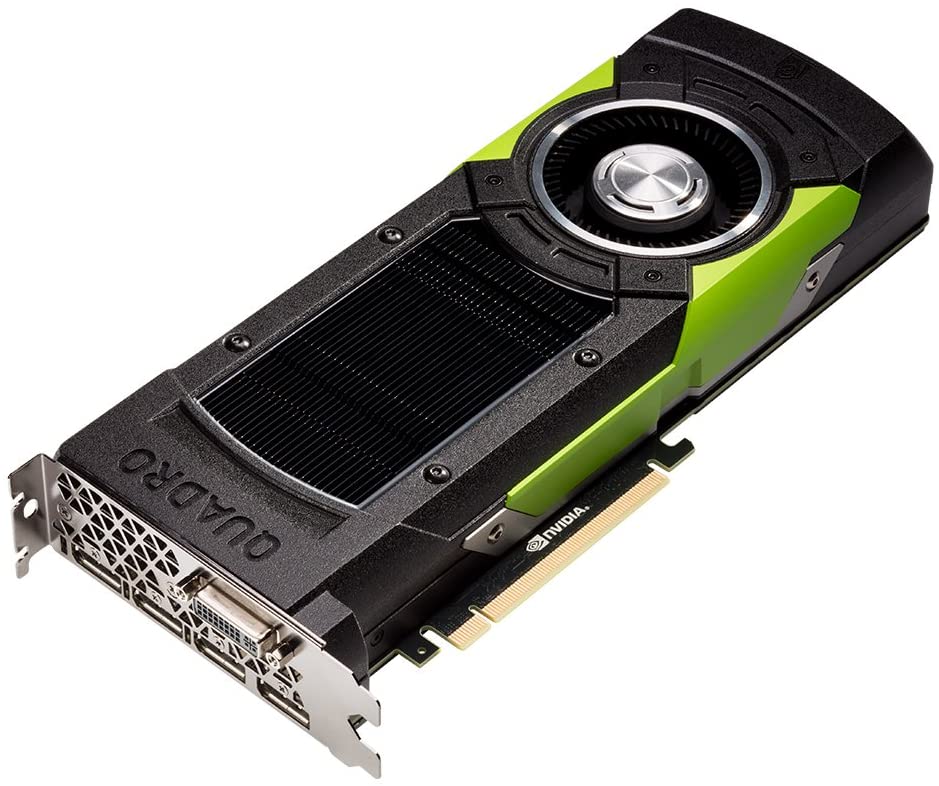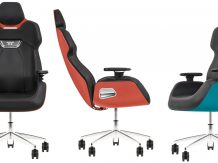NVIDIA Quadro M6000 24 GB Gaming: Review| Benchmark| Testing & Specs | Performance – The situation on the market of professional graphics accelerators is not developing as dynamically as in the gaming segment. Engineers working in the field of computer-aided design and computer modeling are not interested in the frequent change of generations of the video cards they use. If professional software packages increase their appetites, they do it very slowly, so objectively speaking, there is no real need for frequent updating of the hardware filling of workstations.
Very Popular Post: NVIDIA Quadro M6000 24 GB Mining: Hashrate | Benchmark | 250 Watt (K6000)
In contrast, workstation users value the stability of their configurations as it simplifies maintenance and minimizes downtime. That is why the developers of graphic processors usually do not often announce professional accelerators, presenting new solutions only when the next generations of graphic architectures appear that bring clear advantages. For example, if you follow the release dates of the flagship professional video cards of the Quadro family, it turns out that NVIDIA updates them no more than once every two years. And this year we were just looking forward to the release of a new version of the high-performance graphics card for CAD systems. Moreover, NVIDIA now has the progressive Maxwell architecture at its disposal.
Frankly speaking, Maxwell-generation GPUs have been in high-performance gaming cards a long time ago – more than half a year ago. But NVIDIA was in no hurry to introduce such processors into their professional video accelerators. Without experiencing serious pressure in this area from the main competitor, AMD, the NVIDIA developers decided to first wait for the maximum version of the GPU with the highest processing power to appear in their hands, and only then present a truly high-performance professional video card.
Whatever it was, but this moment has come. Almost simultaneously with the advent of the GeForce GTX Titan X gaming accelerator, NVIDIA introduced the “Titan for Professionals” – the Quadro M6000 video card, which replaced the Kepler generation Quadro K6000. Like the GeForce GTX Titan X, the professional novelty is based on the “big Maxwell” – the GM200 GPU, which consists of 8 billion transistors and has 3072 CUDA cores. However, there is one caveat: the Maxwell architecture, in comparison with Kepler, is characterized by a simplified and optimized structure of streaming multiprocessors. On the one hand, this allowed to increase the graphics power, but on the other hand, it did not have the best effect on the computing performance when working with double precision numbers.
As a result, today we received an unusual flagship Quadro video card. If its predecessors, Quadro 6000 and Quadro K6000, could simultaneously serve as both a visualization tool and a high-performance computing complex, the new Quadro M6000 has lost the second role. It is now a card primarily for working in graphic and multimedia applications, similar in functionality to the junior representatives in the line, just faster. For calculations, NVIDIA only has special Tesla cards, which, by the way, have not been transferred to the Maxwell architecture and will not be transferred.
However, all this is unlikely to greatly narrow the audience of potential buyers of Quadro M6000. For its traditional and main purpose – work in CAD and simulation packages, this video card suits perfectly well. And we will be convinced of this below on the example of tests. However, before that, let’s take a closer look at the characteristics and features of the new product.
Learn more about NVIDIA Quadro M6000
So the Quadro M6000 is NVIDIA’s new highest performing graphics card for professional applications. It is based on the 28nm GM200 graphics processor, which is currently used only in another video card – the GeForce GTX Titan X. Hence, the parallels that can be drawn between these two cards are not surprising – in terms of hardware implementation, they are very similar. Although, of course, at the level of the graphics driver, the differences are, as usual, very serious: Quadro M6000 is optimized primarily for the OpenGL graphics API and for professional applications that have their own specifics.
At the same time, the GPU configuration of the Quadro M6000 is almost the same as that of the gaming card. The number of CUDA processors reached 3,072, which is 6 percent more than the previous Quadro K6000. At the same time, NVIDIA indicates that these processors themselves have become about 1.4 times faster in absolute terms and twice as efficient in terms of each watt of energy expended. This gives the new Quadro M6000, whose graphics core operates at a base frequency of 988 MHz (with automatic overclocking to 1114 MHz), the highest performance of 7 Teraflops (on operations with single precision), which is one third higher than that of the previous flagship Quadro series graphics card.
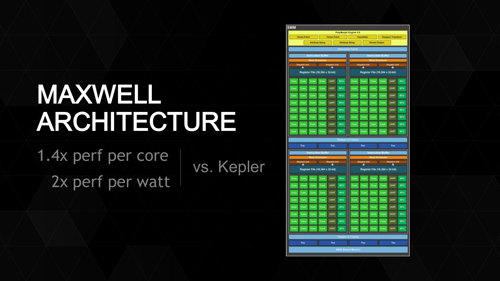
By the way, the technology of dynamic adjustment of the GPU Boost core frequency in the M6000 first came to professional video accelerators. The graphics processor of this video card received 10 different frequency modes ranging from 988 to 1114 MHz, which are selected based on the current operating conditions of the video card. As with gaming accelerators, GPU Boost technology is designed to increase performance while maintaining consumption and heat dissipation within the thermal package.
However, some of the capabilities of the GM200 graphics chip in the Quadro M6000 were cut down. While the number of ROP units is 96, the number of texture units has been reduced to 192, while the GPU has a potential of 256 such units. What was the reason for this decision, it’s hard to say, especially since it turned out that here the Quadro M6000 is inferior to its predecessor. Fortunately, frequency saves the day. Considering that the GM200 chip is capable of operating at higher frequencies than the Kepler generation GK110, the new professional video card still does not lose out to the K6000 in texturing speed.

The volume of GDDR5 video memory in the Quadro M6000 is 12 GB. Today, nobody can be surprised by this: the last flagship in the Quadro line had the same amount of memory, and the new GeForce GTX Titan X also received 12 GB. The memory operating frequency is 1653 MHz, that is, taking into account the 384-bit bus, its bandwidth reaches 317 GB / s. That’s about 10 percent better than the previous Quadro K6000. Just like other high-end professional graphics cards from NVIDIA, the Quadro M6000 supports ECC for memory. Moreover, this function can optionally be enabled or disabled through the driver.
It is necessary to touch in more detail on the “sore spot” – the computing performance of the Quadro M6000 on double precision operations. In graphic work, such calculations are not used, however, they arise in scientific calculations, which theoretically can be performed on professional maps simultaneously with visualizations of the data obtained. That is why we pay such attention to the speed of FP64 operations. But in the GM200 processor, in the process of optimizing its design and for the sake of reducing heat dissipation, each streaming multiprocessor received only four CUDA cores compatible with FP64, so the total performance under such a load is only 1/32 of the peak FP32 performance. And this is very little, especially against the background of the fact that in the professional card of the previous generation Quadro K6000, which used the GPU GK110 of the Kepler generation,
And here, by the way, an opportunity is seen for AMD, whose modern GCN architecture allows creating cards with FP64 performance just half the speed of their operation with FP32 instructions. Be aware, though, that poor double-precision computing performance does not actually completely block the Quadro M6000’s journey into scientific computing. There are numerous applications that are quite capable of getting by with single precision. For example, Quadro M6000 cards can be successfully implemented in artificial intelligence systems, which have recently become more widespread.
In addition, NVIDIA is focusing on the tremendous capabilities of the Quadro M6000 for rendering images using ray tracing. Moreover, at the same time with this video card, the company formally presented the Iray 2015 software for rendering scenes correctly from the point of view of the laws of physics, perfectly optimized for working with the new product and delivering the highest level of performance on it.
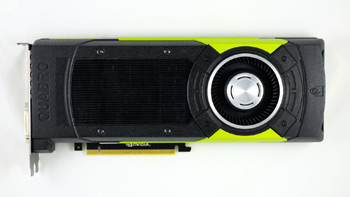

The NVIDIA Quadro M6000 professional graphics card is similar to the GeForce GTX Titan X gaming solution in more than just architecture. These cards are similar in appearance. They use almost the same printed circuit boards, and the only difference in the cooling system can be found in a few decorative elements. In particular, the black shroud of the M6000 cooling system has green overlays, but is devoid of logo illumination, and the reverse side of the PCB is completely covered with a protective plate. In general, the Quadro M6000, like its gaming sister, has a length of 267 mm and occupies two slots in the case. The previous professional flagship, the K6000, was similar in size.
Curiously, the TDP for the Quadro M6000 is set at 250W, which is 25W higher than the Quadro K6000. Formally, this corresponds to the calculated heat dissipation of the GeForce GTX Titan X, but a professional card in practice should consume less, since its texture units are disabled and the clock frequency is lower. This is reflected in the design of the board: oddly enough, but the M6000 manages only one eight-pin connector for additional power, that is, the actual consumption of the M6000 does not seem to actually exceed 225 W. At the same time, the power connector is located not on top of the card, but on the rear edge of the printed circuit board, as is customary in professional video cards.

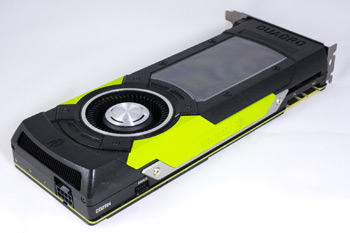
Announcing the Quadro M6000 with yet another graphics performance boost, NVIDIA is now openly stating that the card is not only ideal for single 4K professional monitors, but also well suited for multi-monitor configurations that display a single desktop with ultra -high resolution. The M6000 has also taken a big step forward in this direction by being the first professional solution to work simultaneously with four 4K monitors at 60Hz refresh rate. What’s more, Quadro M6000 owners can seamlessly connect a pair of 60Hz 5K monitors or even one 8K projector to it. If two Quadro M6000 video cards are installed in the workstation, then thanks to Mosaic proprietary technology, such a system will be able to “pull” up to eight 4K-monitors with a refresh rate of 60 Hz, and these monitors can stretch a single desktop. For connecting monitors, each M6000 graphics card offers four DisplayPort 1.2 ports and one Dual-Link DVI-I port. Any four ports from this set can work at the same time.
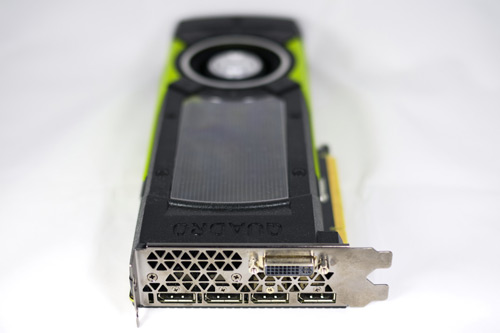
To what has been said, it remains to add that the announced Quadro M6000 is only preliminary – this flagship professional video card will not appear on sale yet, and the terms of real availability are outlined only with the vague phrase “within this year”. Accordingly, there is no information about the cost. However, based on the pricing policy that NVIDIA adheres to its workstation graphics cards, the Quadro M6000 can cost in the region of $ 5000 at the time of sales. To conclude with the newly announced NVIDIA Quadro M6000, let’s summarize its characteristics and compare them with the specifications of the currently available flagship NVIDIA graphics cards for professional users.
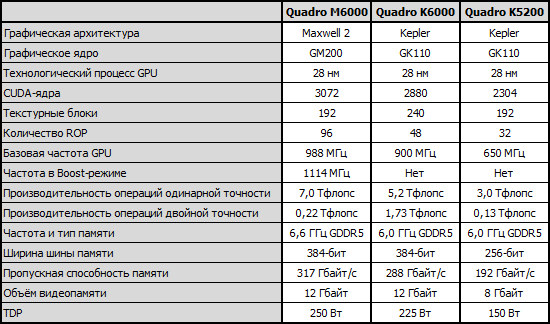
How we tested
We tested professional video cards using a workstation based on the fastest desktop eight-core Intel Core i7-5960X processor with a nominal clock frequency of 3.0 GHz as a platform. Also, the test platform used a motherboard based on the Intel X99 chipset and 16 GB of high-speed DDR4-2666 SDRAM memory. In benchmarking tests, the new professional Quadro M6000 graphics card is compared to the previous flagship based on the Kepler architecture, the Quadro K6000. Thus, the following equipment was used for the tests:
Processor: Intel Core i7-5960X Extreme Edition (Haswell-E, 8 cores + HT, 3.0-3.5 GHz, 20 MB L3).
CPU cooler: Noctua NH-D15.
Motherboard: ASUS X99-Deluxe (LGA 2011-v3, Intel X99).
Memory: 4×4 GB DDR4-2666 SDRAM, 15-17-17-35 (Corsair Vengeance LPX CMK16GX4M4A2666C16).
Video Cards:
Nvidia Quadro K6000 (GK110-2880SP, 12 GB / 384-bit GDDR5, 900/6000 MHz);
Nvidia Quadro M6000 (GM200-3072SP, 12 GB / 384-bit GDDR5, 988-1114 / 6600 MHz).
Disk subsystem: Intel SSD 520 240 GB (SSDSC2CW240A3K5).
PSU: Seasonic Platinum SS-760XP2 (80 Plus Platinum, 760W).
Testing was carried out on Windows 7 Professional SP1 x64 operating system. Used driver versions:
Intel Chipset Driver 10.0.17;
Intel Management Engine Driver 10.0.0.1204;
Intel Rapid Storage Technology 13.2.4.1000;
NVIDIA Quadro Driver Release 347.52.
The video cards were tested at 1920×1200 with Vsync disabled. For testing, we used popular applications for computer-aided design and three-dimensional modeling and tests specially developed by the Standard Performance Evaluation Corporation (SPEC), as well as benchmarks created in our laboratory.
Performance
SPECviewperf 12.0 When testing professional video accelerators, the first thing we always turn to is the synthetic test SPECviewperf, which since its inception has taken the place of the industry standard when initially evaluating the performance of high-performance graphics workstations. Simulating the typical load of the operation, this test shows the “pure geometric” performance of accelerators when working through OpenGL and DirectX, which is determined by both hardware features and the quality of driver optimization. The principle of operation of this test is to transfer pre-formed traces to the graphics driver – sequences of commands that set the visualization of complex models typical for certain professional applications.
The scripts built into SPECviewperf of the twelfth version we are using recreate user activity in projection windows in the following professional applications (the names of the corresponding tests are given in brackets): CATIA V6 R2012 (catia-04), Creo 2 (creo-01), Energy – an abstract software package for geological exploration of oil and gas fields (energy-01), Maya 2013 (maya-04), Medical – proprietary software for volumetric rendering of images generated by KT and MRI scanners (medical-01), Showcase 2013 (showcase-01), Siemens NX 8.0 (snx-02), Solidworks 2013 SP1 (sw-03).
As the results show, the Quadro M6000 represents a significant step forward in graphics performance for professional use. The SPECviewperf benchmark focuses on typical graphics workloads and minimizes the contribution to CPU speed. Thanks to this, we see a significant advantage of the new video card using the Maxwell architecture. The level of its superiority in various tasks averages 40 percent – this is approximately the scale of the increase that NVIDIA promised. However, in some cases, as, for example, in the energy-01 or Siemens NX tests, the novelty demonstrates a truly overwhelming advantage. Autodesk 3ds Max 2015
We performed testing in one of the most popular 3D modeling packages using the professional version of the SPEC test. This benchmark was recently updated, and now we have the opportunity to conduct testing in the most recent version of 3ds max 2015 SP3. This means that the test uses new DirectX 11 shaders, vector maps, the new Nitrous projection window rendering engine, and many modern dynamic and visual effects.

The advantage of the Quadro M6000 over the K6000 does not seem too great – only around 3 percent. However, one should not forget that the speed of work in the projection windows is limited, among other things, by the performance of the central processor. The results of the professional novelty look not too impressive when working with models of high complexity.

The results are almost the same. But do not think that when using the 3ds max 2015 package, the transition to a new graphics card with the Maxwell architecture will have almost no effect. In fact, the Quadro M6000 can perform much better in more demanding graphics performance modes. To see this, just look at the next two diagrams, which show the performance with 8x AA enabled.

Here the picture is completely different. Overall performance increases by a notable 16 percent when moving from the K6000 to the M6000. And if we talk about working with super-complex models, then the advantage of the new architecture is simply overwhelming.

To get a comprehensive understanding of the various aspects of performance in 3ds Max 2015, we also present separate performance indices for different types of operations. The data shown in the graph was taken with 8x AA anti-aliasing enabled.
The advantage at the level of 15-20 percent is the speed increase that can be expected from the new professional video card from NVIDIA. As you can see, even in the most complex professional suites, the Quadro M6000 performs noticeably better than its predecessor. And its inherent low FP64 performance does not at all prevent it from becoming an excellent tool in the hands of specialists working with 3D modeling packages. MAXON Cinema 4D (CINEBENCH R15)
To investigate the performance in the popular package for building three-dimensional models and animation Maxon CINEMA 4D, a specially designed CINEBENCH test was used. This benchmark was recently updated to use the engine from the modern version of the parent package, so it is good for getting an idea of how fast professional graphics cards can run in CINEMA 4D R15 and R16.

Unfortunately, the scene used in CINEBENCH does not load the flagship professional accelerators too much. Therefore, here Quadro M6000 can boast only an advantage of 3.5 percent. Autodesk Maya 2015 The popular 3D editor Maya 2015 is a good example of a typical professional application using the OpenGL interface.

The Quadro M6000’s performance was about 5 percent better than the K6000’s. Moreover, approximately the same superiority of the novelty can be traced when working with three-dimensional models of any type.
It is only when it comes to complex models that the superiority of a more productive architecture is stronger. In this case, we can already say that the M6000 is faster than its predecessor by 6-8 percent. GPU Computing
Before moving on to GPGPU tests, let us recall that the Quadro M6000, unlike its predecessor, is not positioned by the manufacturer as a suitable choice for solving parallel computing tasks. For this, another line of accelerators is intended – NVIDIA Tesla, which continue to use the older Kepler architecture. This is due to the fact that the relatively high characteristics of the computing power Quadro M6000 can offer only for single precision real operations, while there are frankly few double precision blocks in these cards: this is a feature of the Maxwell architecture.
All this can be well illustrated by the GPGPU benchmark from the SiSoftware Sandra 2014 package, which, using the OpenCL and CUDA frameworks, constructs the Mandelbrot set with different accuracy, performing calculations on GPUs.
The diagrams perfectly show the fact that the FP32 performance of the Quadro M6000 is noticeably higher than that of the K6000, and that when working with higher accuracy, the new card with Maxwell architecture cannot offer sufficient performance. Moreover, the difference in the speed of working with real data of double and quadruple precision reaches 5-8 times, which, frankly, makes us not consider the M6000 as any suitable candidate for serious calculations with high precision. However, in fairness, it should be noted that calculations with high accuracy using graphics adapters are rarely used today, and the overwhelming majority of GPGPU software operates with single precision numbers.
For example, professional graphics cards are often used in final rendering. Many rendering algorithms are freely portable to parallel GPU processors, and due to this, they are able to perform more efficiently. One example of rendering engines capable of harnessing the power of graphics cards through the generic OpenCL API is LuxRender, which renders images using ray tracing. LuxRender simulates the propagation of light in reality using special algorithms and is available in versions for the following specialized software: Blender, 3dsmax, SketchUp, C4D, XSI, Poser, etc.
To test the speed of LuxRender, we used a specialized test application LuxMark 3.0 and two scenes: Newmann TLM-102 SE of medium difficulty and Hotel Lobby with high difficulty.


It uses exclusively FP32 operations, so the Quadro M6000 shows a significantly higher speed than the Quadro K6000. This means that the new professional map is very well suited for ray tracing rendering. Obviously, approximately the same ratio of results will be observed in the proprietary renderer NVIDIA Iray 2015. Another test, on the basis of which we made conclusions about computing performance, was the cross-platform CompuBench CL. It is able to estimate the computational speed of GPUs under different workloads, for example, when physically simulating particles or a surface of a liquid, or when recognizing faces.
Double precision calculations are not used here either. Therefore, we see again that the new older Quadro is much faster than the old one. However, it should be borne in mind that in the CompuBench CL benchmark, higher results from professional cards are given by AMD offerings, the computing performance of which is higher than that of NVIDIA products. With the growth of typical video resolutions and the increase in the complexity of various effects, professionals involved in the creation and processing of content began to desperately need their own computing accelerators. Professional graphics cards are well suited for this role: their stream processors are great at both encoding and applying video effects.
To assess the potential of professional accelerators in video processing, we used the popular Adobe Premiere Pro CC 2014 nonlinear video editing package, in which the video was rendered with the imposition of various effects. The following diagram shows the render times of a test task using the GPU-accelerated Mercury Playback Engine running through CUDA.

The increase in video rendering speed in Premiere Pro CC 2014 on the Quadro M6000 is noticeable, but not particularly significant. Unfortunately, along the way, we were not able to test how this video card works in the popular Adobe After Effects CC 2014 compositing, animation and post-production package, because it does not yet have compatibility with the new product. Futuremark 3DMark Although professional accelerators are almost never used for gaming, we decided to add the result of the popular FutureMark 3DMark FireStrike gaming benchmark, which may allow you to look at today’s test participants from a different angle.
The new Quadro M6000 is similar in its characteristics to the GeForce GTX Titan X. The predecessor Quadro K6000 is an analogue (with certain assumptions) of the GeForce GTX Titan with slightly lower frequencies. Therefore, more than 1.5 times the gap between the cards in the gaming benchmark should not be surprising. You could see a similar ratio in the results in the tests of the new gaming accelerator based on the “big Maxwell”, but in this case it is amplified by the gap in frequencies, which, with the advent of a new generation of professional video accelerators, was additionally reinforced by the introduction of GPU Boost auto-overclocking technology.
Power consumption and temperature
In this section, we present the actual power consumption of complete systems (without a monitor) equipped with various professional graphics cards. The following graphs show the total system consumption (without monitor) measured at the outlet of the test system’s power supply, which is the sum of the power consumption of all components involved in the system. The total indicator automatically includes the efficiency of the power supply itself, however, given that the PSU model we use, Seasonic Platinum SS-760XP2, is certified 80 Plus Platinum, its effect should be minimal.
The measurements were carried out both at rest and under load – during the FurMark 1.15.1 test, run in the “Burn” mode in a window with a resolution of 1280×720. This test is good because, like most professional applications, it uses OpenGL, and besides, it creates a significant load on the video subsystem.


As you can see from the results obtained, the Quadro M6000 is a noticeably more power hungry card than its predecessor. Despite the fact that the thermal package of the newer professional accelerator is only 25 W higher, the actual consumption of the system with the M6000 turned out to be almost 70 W more than that of the similar platform with the K6000. This is partly due to the fact that the M6000 can manage its thermal package more efficiently. Thanks to GPU Boost technology, the card dynamically monitors the actual parameters and has the ability to adjust its clock frequency for specific operating conditions.
For a more detailed understanding of the thermal performance of the Quadro M6000, see the following graph, which dynamically displays the GPU frequency and temperature when running FurMark 1.15.1. We also placed a fan speed graph next to it, which gives an understanding of how high the noise level is produced by the video card in question.

The cooling system of the Quadro M6000 keeps the GPU temperature within 85 degrees. At the same time, the fan accelerates to 2500 rpm, but the main means of keeping the heat dissipation of the video card within the established framework is not this, but the frequency reduction. As you can see from the graph, the GPU does not work for long at the nominal 987 MHz, and then the frequency drops first to 860 MHz, and then to 784 MHz. Here is such a GPU Boost on the contrary. So you shouldn’t be surprised that the TDP of the M6000 is limited to 225 W – the card uses the GPU frequency according to a very conservative algorithm.
However, don’t be under the impression that the claims about the automatic GPU overclocking capability on the Quadro M6000 are empty words. It all depends on how severe the load on the GPU is created by each particular application. For example, here is how the frequency behaves during the Cinebench test.
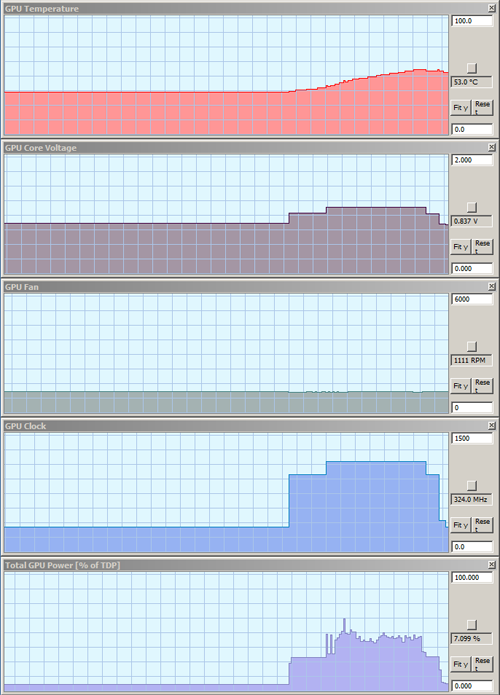
Here, the graphics processor really accelerates to 1151 MHz, while its temperature remains very low, and the fan does not see the need to increase its rotation speed above the minimum 1100 rpm at all.
conclusions
The Quadro M6000 graphics card, for which NVIDIA used its latest GM200 chip, also known as “Big Maxwell”, is, as expected, an excellent professional video accelerator. And it could not be otherwise, because the technologies do not stand still, and the new GPU, which is the basis of the M6000, has a higher theoretical performance and better capabilities than the GK110 processor used in senior professional NVIDIA cards of the previous generation. As a result, the Quadro M6000 differs from the predecessor Quadro K6000 in the significantly increased speed of work in engineering software packages and the broader capabilities of work with 4K monitors, which are gradually gaining popularity in the professional environment. This means that the Quadro M6000, subject to NVIDIA’s well-thought-out pricing policy,

The potential that the Quadro M6000 offers to professional users can be used in a wide range of different tasks, from CAD and engineering packages to the creation of multimedia and entertainment content. The graphics capabilities of the GM200 make the new product a first-class solution for hardware accelerated rendering in professional packages, and support for CUDA allows the Quadro M6000 to be used in tasks of physically accurate rendering and in some types of calculations.
Of course, one should not overlook the fact that all processors of the Maxwell generation have severely limited FP64 performance. Therefore, the Quadro M6000, unlike, for example, its predecessor, is poorly suited for solving scientific problems where double precision calculations are required. But in fact, this does not greatly limit the scope of the novelty. Such accuracy is needed only in certain highly specialized applications, and most professional packages are perfectly fine with single-precision calculations alone. In other words, with the advent of the Quadro M6000 in the range of NVIDIA accelerators, there will simply be clearer and more explicit segmentation. The Quadro series will be primarily targeted at design, modeling and engineering,
And if you approach the Quadro M6000 exactly as a professional graphics accelerator (with an emphasis on the word “graphics”), then it really represents another step forward compared to the flagship video card of the previous generation. This is not to say that this step is revolutionary, but engineers who use Quadro cards in their professional activities will surely be pleased with the evolutionary changes that the M6000 can bring.





